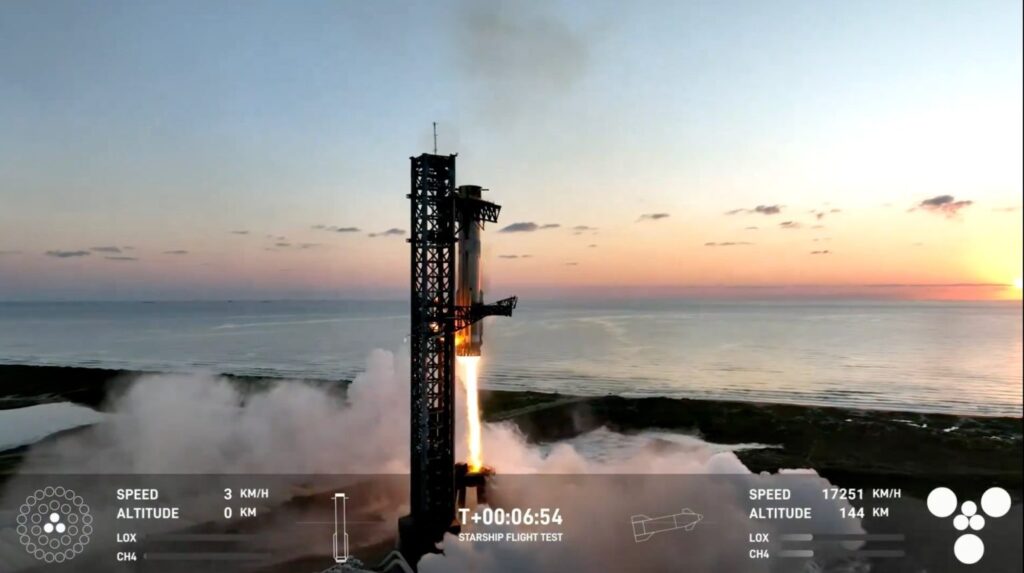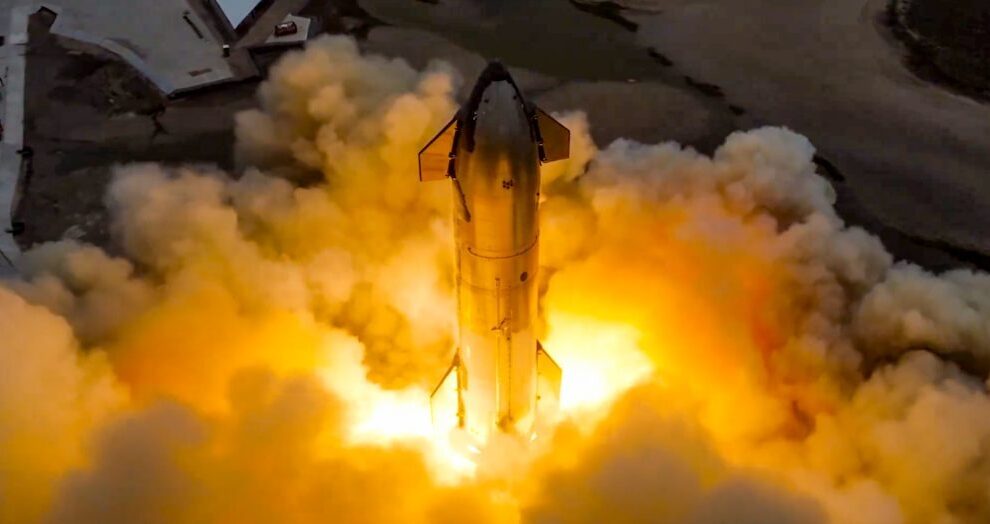In a bold move that could revolutionize space travel, SpaceX CEO Elon Musk has confirmed the company’s plans to take its Starship catch capabilities to new heights. Following the successful catch of the Super Heavy booster during a recent test launch, SpaceX now aims to catch both stages of the Starship rocket system – a feat that could redefine the economics and efficiency of space exploration.

The Recent Milestone: Catching Super Heavy
On Sunday, SpaceX achieved a remarkable breakthrough in rocket technology:
- Successfully caught the Super Heavy booster (Starship’s first stage) on the launch tower, nicknamed “Mechazilla”.
- This was the first attempt at such a maneuver in the four Starship test launches to date.
- The catch was executed flawlessly, marking a significant step forward in SpaceX’s reusability goals.
This achievement is crucial because it allows SpaceX to:
- Reuse boosters for multiple launches, significantly reducing costs.
- Streamline the launch process for future missions.
- Minimize turnaround time between launches.
The Next Big Step: Catching Both Stages
Elon Musk has now set his sights on an even more ambitious goal:
- Catching both the Super Heavy booster and the upper stage (Starship itself) in a single mission.
- This dual-stage catch attempt is planned for sometime next year.
- If successful, it would represent a quantum leap in rocket reusability and efficiency.
Technical Challenges and Innovations
Catching both stages of Starship presents numerous technical challenges:
1. Precision Control
- Both stages must be guided with extreme precision to their respective catch points.
- This requires advanced guidance systems and real-time adjustments during descent.
2. Structural Integrity
- Both the booster and the upper stage must withstand the forces of reentry and landing.
- Engineers must ensure that the catch mechanism doesn’t damage the rocket components.
3. Timing and Coordination
- The catch of both stages must be precisely timed and coordinated.
- This may require two separate catch mechanisms or a single, highly versatile system.
4. Propulsion Systems
- Both stages need refined propulsion systems for controlled descent and positioning.
- Fuel management becomes crucial to ensure enough propellant for landing maneuvers.
5. Weather and Environmental Factors
- The catch system must be robust enough to operate in various weather conditions.
- Wind patterns and atmospheric conditions will play a crucial role in the success of the catch.
Implications for Space Exploration
The successful implementation of a dual-stage catch system could have far-reaching implications for space exploration:
1. Cost Reduction
- Dramatically lower launch costs by reusing both stages of the rocket.
- Make space missions more economically viable for a wider range of applications.
2. Increased Launch Frequency
- Faster turnaround times between launches due to minimal refurbishment needs.
- Enable more frequent missions to space, accelerating research and exploration.
3. Environmental Impact
- Reduce space debris by recovering all major components of the launch vehicle.
- Lower the environmental footprint of space launches.
4. Advanced Space Infrastructure
- Facilitate the construction of large-scale space structures and stations.
- Enable more ambitious deep space missions with reusable components.
5. Mars Colonization
- Support SpaceX’s goal of Mars colonization by making interplanetary travel more sustainable.
- Allow for the transport of larger payloads to Mars at lower costs.
The Road to Mars: SpaceX’s 2026 Vision
SpaceX’s ambition to catch both stages of Starship is part of a larger plan leading up to test flights to Mars in 2026. This timeline highlights the rapid pace of development and the company’s commitment to pushing the boundaries of space technology.
Key Milestones on the Path to Mars:
- 2024: Perfecting the dual-stage catch system.
- 2025: Potential uncrewed test flights to Mars orbit or surface.
- 2026: First crewed test flights to Mars.
The success of the dual-stage catch system is crucial for these ambitious plans, as it would:
- Ensure the reliability and reusability needed for frequent Mars missions.
- Reduce the cost per mission, making a sustained Mars program more feasible.
- Allow for larger payloads to be sent to Mars, crucial for establishing a human presence.
Industry Impact and Competition
SpaceX’s advancements in reusable rocket technology are likely to have a significant impact on the aerospace industry:
1. Competitive Pressure
- Other space companies may feel compelled to develop similar reusability technologies.
- This could accelerate innovation across the entire industry.
2. New Business Models
- The economics of space launch services may need to be reevaluated.
- New opportunities may arise for companies focusing on space-based services and manufacturing.
3. Government and Private Partnerships
- Increased interest from government space agencies in partnering with private companies.
- Potential for new types of public-private partnerships in space exploration.
4. Global Space Race
- May intensify the global competition in space technology and exploration.
- Could lead to increased investment in space programs worldwide.
Challenges and Considerations
While the prospect of catching both Starship stages is exciting, several challenges and considerations remain:
1. Safety Concerns
- Ensuring the safety of ground personnel during the catch maneuver.
- Developing fail-safe mechanisms in case of a missed catch.
2. Regulatory Hurdles
- Obtaining necessary approvals from space agencies and regulatory bodies.
- Addressing potential concerns about the environmental impact of frequent launches.
3. Technical Reliability
- Achieving consistent success rates in catching both stages.
- Dealing with potential variations in performance due to payload differences.
4. Economic Viability
- Balancing the cost of developing and maintaining the catch system against launch cost savings.
- Ensuring that the reusability translates into actual cost reductions for customers.
Future Prospects and Possibilities
The successful development of a dual-stage catch system could open up new possibilities in space exploration and technology:
1. Interplanetary Transport Network
- Establishment of regular, cost-effective transport between Earth and Mars.
- Potential for extending the system to other planetary bodies in the solar system.
2. Space Tourism
- Making space travel more accessible and affordable for civilian tourists.
- Enabling more frequent and diverse space tourism experiences.
3. Orbital Manufacturing
- Facilitating the construction and maintenance of large-scale orbital factories.
- Enabling new industries that rely on microgravity or space-based resources.
4. Deep Space Exploration
- Using reusable technology as a stepping stone for missions to the outer solar system.
- Potential for establishing permanent bases on the Moon and Mars.
Conclusion
SpaceX’s ambition to catch both stages of Starship represents a pivotal moment in the history of space exploration. If successful, this technology could dramatically reduce the cost of space travel, increase the frequency of launches, and open up new possibilities for human presence in space.
While significant technical and regulatory challenges lie ahead, the potential benefits of this innovation are immense. From enabling Mars colonization to revolutionizing the economics of space travel, the dual-stage catch system could be a key enabler of humanity’s future as a multi-planetary species.
As SpaceX works towards its goal of Mars test flights in 2026, the development and testing of this catch system will be closely watched by the space industry, scientists, and space enthusiasts alike. The success of this endeavor could mark the beginning of a new era in space exploration, one where the boundaries of what’s possible are pushed further than ever before.










Add Comment